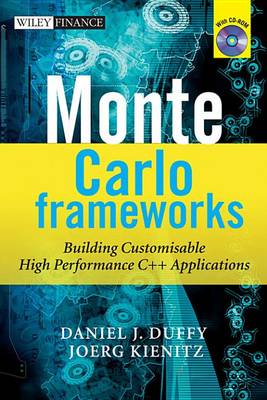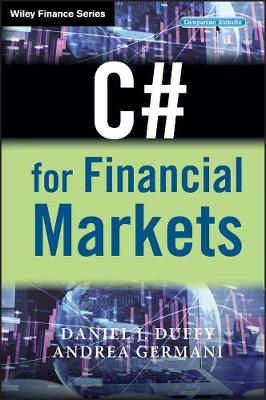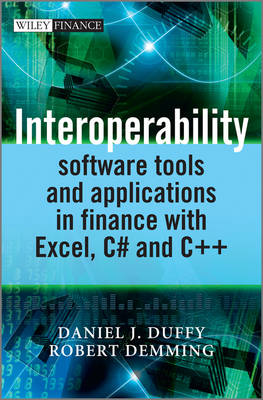Wiley Finance
2 primary works • 6 total works
Book 312
In this book we apply the same techniques to pricing real-life derivative products. We use both traditional (or well-known) methods as well as a number of advanced schemes that are making their way into the QF literature:* Crank-Nicolson, exponentially fitted and higher-order schemes for one-factor and multi-factor options* Early exercise features and approximation using front-fixing, penalty and variational methods* Modelling stochastic volatility models using Splitting methods* Critique of ADI and Crank-Nicolson schemes; when they work and when they don't work* Modelling jumps using Partial Integro Differential Equations (PIDE)* Free and moving boundary value problems in QF Included with the book is a CD containing information on how to set up FDM algorithms, how to map these algorithms to C++ as well as several working programs for one-factor and two-factor models. We also provide source code so that you can customize the applications to suit your own needs.
Book 601
The stochastic-local-volatility Libor market model with time-dependent parameters is considered and as an application how to price and risk-manage CMS spread products is demonstrated. The second part of the book deals with numerical methods which enables the reader to use the models of the first part for pricing and risk management, covering methods based on direct integration and Fourier transforms, and detailing the implementation of the COS, CONV, Carr-Madan method or Fourier-Space-Time Stepping. This is applied to pricing of European, Bermudan and exotic options as well as the calculation of the Greeks. The Monte Carlo simulation technique is outlined and bridge sampling is discussed in a Gaussian setting and for Levy processes. Computation of Greeks is covered using likelihood ratio methods and adjoint techniques. A chapter on state-of-the-art optimization algorithms rounds up the toolkit for applying advanced mathematical models to financial problems and the last chapter in this section of the book also serves as an introduction to model risk.
The third part is devoted to the usage of Matlab, introducing the software package by describing the basic functions applied for financial engineering. The programming is approached from an object-oriented perspective with examples to propose a framework for calibration, hedging and the adjoint method for calculating Greeks in a Libor Market model. Source code used for producing the results and analysing the models is provided on the author s dedicated website, http://www.mathworks.de/matlabcentral/fileexchange/authors/246981
A practice-oriented guide to using C# to design and program pricing and trading models
In this step-by-step guide to software development for financial analysts, traders, developers and quants, the authors show both novice and experienced practitioners how to develop robust and accurate pricing models and employ them in real environments. Traders will learn how to design and implement applications for curve and surface modeling, fixed income products, hedging strategies, plain and exotic option modeling, interest rate options, structured bonds, unfunded structured products, and more. A unique mix of modern software technology and quantitative finance, this book is both timely and practical. The approach is thorough and comprehensive and the authors use a combination of C# language features, design patterns, mathematics and finance to produce efficient and maintainable software.
Designed for quant developers, traders and MSc/MFE students, each chapter has numerous exercises and the book is accompanied by a dedicated companion website, www.datasimfinancial.com/forum/viewforum.php?f=196&sid=f30022095850dee48c7db5ff62192b34, providing all source code, alongside audio, support and discussion forums for readers to comment on the code and obtain new versions of the software.
This book shows you how to make these languages interact efficiently, accurately, and productively to create more effective solutions for todays finance world. * Create automation and COM add-ins with C# and C++ * Call VBA add-ins and handle multi-threaded components with Excel * Implement interpolators, pricers, and simulators in Excel * Integrate C++ STL, Boost, and other libraries Haphazard multi-language interfacing slows down results, causes numerous errors, and can require complete reworking when changes are made. Today's applications need to move at a steady pace, and developer time cannot be wasted on tedious integration and revision. Interoperability Software Tools and Applications in Finance with Excel, C#, and C++ provides a sound, concrete solution, making it a must-have resource for developers and quantitative finance specialists.
This book is a detailed and step-by-step introduction to the mathematical foundations of ordinary and partial differential equations, their approximation by the finite difference method and applications to computational finance. The book is structured so that it can be read by beginners, novices and expert users.
Part A Mathematical Foundation for One-Factor Problems
Chapters 1 to 7 introduce the mathematical and numerical analysis concepts that are needed to understand the finite difference method and its application to computational finance.
Part B Mathematical Foundation for Two-Factor Problems
Chapters 8 to 13 discuss a number of rigorous mathematical techniques relating to elliptic and parabolic partial differential equations in two space variables. In particular, we develop strategies to preprocess and modify a PDE before we approximate it by the finite difference method, thus avoiding ad-hoc and heuristic tricks.
Part C The Foundations of the Finite Difference Method (FDM)
Chapters 14 to 17 introduce the mathematical background to the finite difference method for initial boundary value problems for parabolic PDEs. It encapsulates all the background information to construct stable and accurate finite difference schemes.
Part D Advanced Finite Difference Schemes for Two-Factor Problems
Chapters 18 to 22 introduce a number of modern finite difference methods to approximate the solution of two factor partial differential equations. This is the only book we know of that discusses these methods in any detail.
Part E Test Cases in Computational Finance
Chapters 23 to 26 are concerned with applications based on previous chapters. We discuss finite difference schemes for a wide range of one-factor and two-factor problems.
This book is suitable as an entry-level introduction as well as a detailed treatment of modern methods as used by industry quants and MSc/MFE students in finance. The topics have applications to numerical analysis, science and engineering.
More on computational finance and the author’s online courses, see www.datasim.nl.



